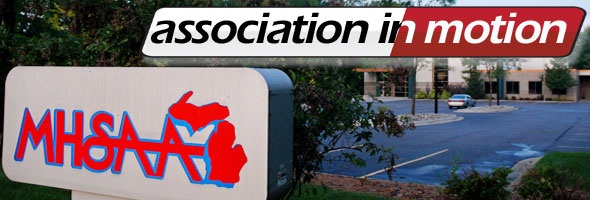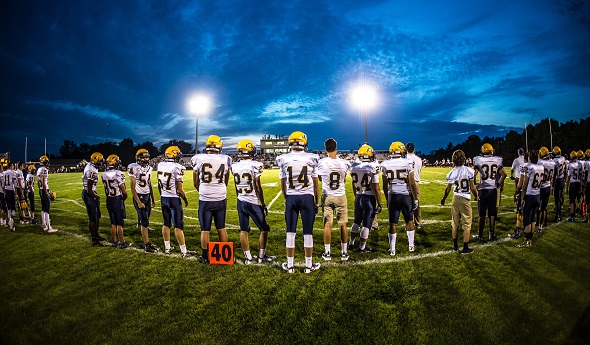
Winter Preliminary Concussion Data Announced
May 3, 2016
By Geoff Kimmerly
Second Half editor
The Michigan High School Athletic Association has found through collection of preliminary data that fewer than two percent of its more than 70,000 winter student-athletes experienced potential concussions during the season that concluded in March.
The MHSAA this school year requested for the first time that member schools report possible concussions by their student-athletes during both practice and competition. A first set of preliminary data announced in December showed only two percent of more than 100,000 high school fall athletes experienced concussions during that first season of the 2015-16 school year.
As it did for the fall, the MHSAA again received data from more than 99 percent of its member high schools at the end of the winter season. The average number of possible winter concussions reported by member high schools through May 2, 2016, was 1.6 concussions per school – half the average per school reported for the fall season. Just more than 39 percent of reporting schools stated they had no concussions by athletes this winter.
Girls and boys basketball, by far the most popular winter sports by participation, also revealed the highest percentage of winter concussions. Girls basketball, with 22 percent of all winter athletes, revealed 38 percent of possible concussions. Boys basketball, with 30 percent of winter athletes, followed with approximately 20 percent of reported possible concussions. Wrestling, with 13 percent of winter athletes, also registered approximately 20 percent of possible concussions.
In addition to breakdowns by sport, the breakdown by gender this winter also was significant. Total, girls make up approximately 38 percent of athletes who compete during the winter season – and girls experienced 48 percent of the possible concussions reported.
“This second set of preliminary data continues to tell a story behind concussions that we anticipated,” MHSAA Executive Director John E. “Jack” Roberts said. “Most importantly, these findings show that concussions are affecting our female athletes just as much as our male athletes. Concussion care is not a football-focused issue, but something we must work to improve for both genders and across all sports. Eventually we will want to encourage and support research that might inform as to why, beyond differences in physiology, more concussions are reported for girls than for boys.”
Data collected by the MHSAA remains preliminary, in part, because results noted include pending reports that have not been verified. After completion of these follow-up reports, the final number of concussions that actually occurred this past season and during the fall may be lower than the preliminary numbers being reported at this time.
The data analyzed to date is for high schools only, although middle schools also have the opportunity to report possible concussions. A full breakdown of the data including concussions by gender, sport, team level (varsity through junior high) and setting (practice or event) will be reported after the conclusion of this spring 2016 season.
The reporting of possible concussions is part of a three-pronged advance by the MHSAA in concussion care during the 2015-16 school year which is producing data related to the frequency and severity of head injuries. The MHSAA this fall launched the largest ever state high school association sideline concussion testing pilot program, with 62 schools taking part by using one of two screening tests designed to detect concussions. One of the objectives of the pilot is to increase awareness of concussions and improve sideline detection; and preliminary results indicate that the average number of possible concussions reported by pilot schools exceeds the average reported by schools outside the pilot group.
Of 30 schools reporting the most possible concussions this winter, seven are part of the MHSAA’s pilot sideline detection programs. Those programs – King-Devick Test and XLNTbrain Sport – utilize technology to provide on-site testing of athletes who have sustained possible concussions, with results of those examinations then compared against baseline tests taken by athletes previously.
The MHSAA also is the first state association to provide all participants at every member high school and junior high/middle school with insurance intended to pay accident medical expense benefits – covering deductibles and co-pays left unpaid by other policies – resulting from head injuries sustained during school practices or competitions and at no cost to either schools or families. The program will produce additional data about the frequency and severity of head injuries. After the fall and winter seasons, only 110 claims have been made on the insurance policy designed to assist in payment for concussion care. Twenty-nine of the claims are for basketball (girls and boys combined), seven are for wrestling and five for injuries experienced during ice hockey activities.
Schools report possible concussions online via the MHSAA Website. Reports are then examined by members of the MHSAA staff, who follow up with school administrators as those student-athletes continue to receive care and eventually return to play. Student privacy is protected.
Previously, the MHSAA also was among the first state associations to adopt a return-to-play protocol that keeps an athlete out of activity until at least the next day after a suspected concussion, and allows that athlete to return to play only after he or she has been cleared for activity by a doctor (M.D. or D.O.), physician’s assistant or nurse practitioner. The follow-up reports schools are providing the MHSAA reveal that the majority of students are being withheld from activity for a week or longer following the reported concussion. This will be discussed in more detail when the MHSAA releases a more comprehensive review that covers the entire school year.
The MHSAA is a private, not-for-profit corporation of voluntary membership by more than 1,400 public and private senior high schools and junior high/middle schools which exists to develop common rules for athletic eligibility and competition. No government funds or tax dollars support the MHSAA, which was the first such association nationally to not accept membership dues or tournament entry fees from schools. Member schools which enforce these rules are permitted to participate in MHSAA tournaments, which attract more than 1.4 million spectators each year.

MHSAA Opposes Big Ten Friday Football
November 2, 2016
By Geoff Kimmerly
Second Half editor
The executive director of the Michigan High School Athletic Association said today that he is “disappointed and disheartened” by the Big Ten Conference announcement that it will play and televise football games on Friday nights beginning with the 2017 season.
Friday night football remains one of the strongest and longest-standing traditions in high school athletics, and the MHSAA has fought since the start of this century to keep Friday nights sacred against the overstepping of college football and the damage televised Big Ten games are now expected to cause to attendance and media coverage of the sport at the high school level.
MHSAA Executive Director John E. “Jack” Roberts was contacted by both Big Ten Conference commissioner Jim Delany and Michigan State University athletic director Mark Hollis before the decision was announced. Roberts said he is appreciative of Michigan State and University of Michigan’s low tolerance to be included in this venture – at most, both will host a Thursday or Friday night game during Labor Day weekend and play one Friday night away game during the remainder of a season – but remains frustrated that similar respect for high school football was not shown by the conference as a whole.
Michigan State has played Friday night games during Labor Day weekend the last six seasons, hosting five and playing at Western Michigan University in 2015. However, most Michigan high school games continue to be scheduled and played on the Thursday before Labor Day, relieving holiday travel conflicts in most communities. University of Michigan did play on the Thursday before Labor Day at University of Utah in 2015, but has not played on a Friday night of Labor Day weekend this decade. The Wolverines are one of five Big Ten schools without a Friday night game in 2017.
“We are saddened by this decision. We had hoped that the Big Ten Conference would stay above this. We think this cheapens the Big Ten brand,” Roberts said. “Fans won’t like this. Recruits won’t like this. And high school football coaches won’t like this.
“We are grateful that Michigan State University and the University of Michigan are trying to minimize the effects of this decision by the Big Ten. But overall, this is just the latest step by major college athletics in the pursuit of cash that is just crushing high school sports.”
The MHSAA has shown its opposition to the use of Friday nights for televised collegiate football games for more than 15 years, dating back to 2001 when the NCAA lifted its restrictions on Friday night telecasts, which at first led to the broadcasting of “mid-major conference” games on the same night traditionally reserved for high school athletes.
The MHSAA launched in 2001 its “Save Our Friday Nights” campaign to emphasize the role that Friday night high school athletic events play in communities and to rally MHSAA member schools to contact NCAA member school football coaches, athletic directors and conference commissioners to voice their concerns.
In addition to causing lower attendance at events going up against Big Ten football games, Roberts anticipates that Friday night college games also will leave high school football as a secondary priority in many media markets. More than 80 radio stations statewide cover high school games regularly, but many also carry Michigan State or University of Michigan football. High school football could lose significant time on local TV highlights shows and in print and online coverage as well, as resources are diverted to cover a college game – potentially quieting significantly the positive buzz that comes from the typical high school football Friday night.
“Everyone knows that football is struggling right now,” Roberts said. “It’s getting a lot of bad publicity. Participation is declining. And now this; there couldn’t be worse timing.”
PHOTO: Grand Ledge takes on Okemos under the Friday night lights this season. (Click to see more from HighSchoolSportsScene.com.)

